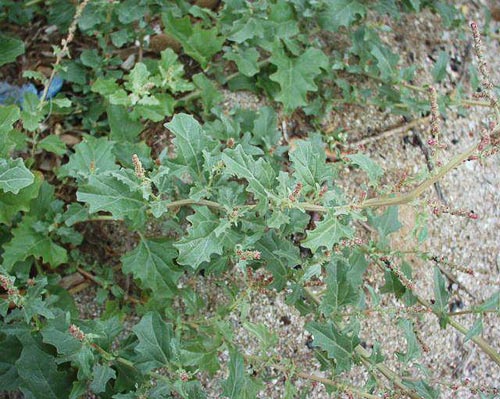Weeds
Atriplex tatarica L. - Tatarian Orache.
Systematic position.
Family Chenopodiaceae Vent., genus Atriplex L.Synonyms.
Atriplex laciniata L., Atriplex arenaria J.Woods.Biological group.
Spring annual weed.Morphology and biology.
Plant is 10-100 cm in height, with straight stem that may lie horizontally along the ground. Leaves are alternate, petiolate, triangular-oblong or ovate-oblong; more seldom they are narrower, repand-serrate or lociniate; often hairy along the edge, very shortly apiculate. Flowers are clustered in leafless, terminal, spike-shaped inflorescences, which are leafy only in their lower part. Antheral flowers are divided into 5 parts, pistillates are clustered in whorls in groups of 3-20 without perianth and are wrapped in two bracts with a very short stalk, which intergrows only in the lowest part. Seeds are round, lustrous, glabrous, and brown. A. tatarica flowers and bears fruit in July-September. Minimum temperature for seed germination is 3-4°C; optimum is 18-22°C.Distribution.
European part of the Former Soviet Union (an adventive plant in the north and west), Caucasus, south of Western Siberia, and Central Asia. General distribution: northern and southern Europe, Balkan Peninsula, Asia Minor, Iran, Mongolia, Tibet, India, and the Himalayas. In North America and Australia it is an adventive plant.Ecology.
Heat-resistant. This weed sustains soil salinity well. It thrives in soils with low salinity, reaching the height of a man. It grows in groups and forms thickets.Economic significance.
A. tatarica is a widely distributed weed, especially in steppe and desert zones. Weed in cotton and alfalfa fields, in vegetable gardens, gardens, and vineyards. As a ruderal plant, it occurs in salt-marshes, sod fields, pastures, along roads, and in river valleys. It is edible to all species of agricultural animals during the entire period of vegetation. This plant is rich in both sodium and potassium salt. It might serve as a source of potash. Its young leaves are used as food. It might serve as a horticultural plant. Control measures include thorough soil treatment and the eradication of the weed from uncultivated lands.Related references.
Keller, B.A., ed. 1934. Weed plants of the USSR. V. 2. Leningrad: AN SSSR. p.120. (in Russian).Komarov, V.L. & Shishkin, B.K., eds. 1936. Flora of the USSR. V.6. Moscow-Leningrad: AN SSSR. p.95-6. (in Russian).
Nikitin, V.V. 1983. Weed plants of the USSR flora. Leningrad: Nauka. p.164. (in Russian).
Ulyanova, T.N. 1998. Weed plants in flora of Russia and other CIS countries. St.Petersburg: VIR. p.118, 211. (in Russian).
Visyulina, O.D., ed. 1970. Weed plants of Ukraine (reference-identification guide). Kiev: Naukova Dumka. p. 105-106. (in Ukrainian).


